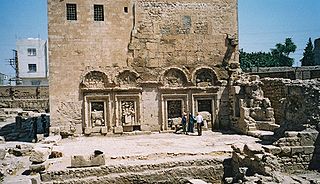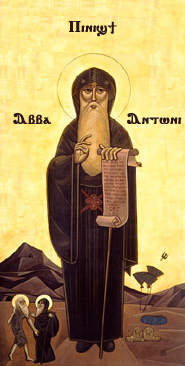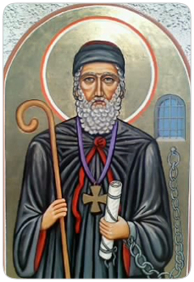
Tur Abdin is a hilly region situated in southeast Turkey, including the eastern half of the Mardin Province, and Şırnak Province west of the Tigris, on the border with Syria and famed since Late Antiquity for its Christian monasteries on the border of the Roman Empire and the Sasanian Empire. The area is a low plateau in the Anti-Taurus Mountains stretching from Mardin in the west to the Tigris in the east and delimited by the Mesopotamian plains to the south. The Tur Abdin is populated by more than 80 villages and nearly 70 monastery buildings and was mostly Syriac Orthodox until the early 20th century. The earliest surviving Christian buildings date from the 6th century.

The School of Nisibis was an educational establishment in Nisibis. It was an important spiritual centre of the early Church of the East, and like the Academy of Gondishapur, it is sometimes referred to as the world's first university. The school had three primary departments teaching: theology, philosophy and medicine. Its most famous teacher was Narsai, formerly head of the School of Edessa.
Babai the Great was an early Assyrian church father of the Church of the East. He set several of the foundational pillars of the Church, revived the monastic movement, and formulated its Christology in a systematic way. He served as a monastic visitor and coadjutor with Mar Aba as unofficial heads of the Church of the East after Catholicos Gregory until 628 AD, leaving a legacy of strong discipline and deep religious Orthodoxy. He is revered in the modern Assyrian Church of the East and Ancient Church of the East.

Henana of Adiabene was a Christian theologian, and headmaster of the School of Nisibis, the main theological center of the Church of the East (571–610).

Cenobiticmonasticism is a monastic tradition that stresses community life. Often in the West the community belongs to a religious order, and the life of the cenobitic monk is regulated by a religious rule, a collection of precepts. The older style of monasticism, to live as a hermit, is called eremitic. A third form of monasticism, found primarily in Eastern Christianity, is the skete.
Abraham the Great of Kashkar was the father of the Assyrian monastic revival in the 6th century. He is a doctor and saint of the Church of the East.

Eastern Christian monasticism is the life followed by monks and nuns of the Eastern Orthodox Church, Oriental Orthodoxy, the Church of the East and some Eastern Catholic Churches.

Aba I or Mar Abba the Great was the Patriarch of the Church of the East at Seleucia-Ctesiphon from 540 to 552. He introduced to the church the anaphoras of Theodore of Mopsuestia and Nestorius beside the more ancient liturgical rite of Addai and Mari. Though his tenure as catholicos saw Christians in the region threatened during the Persian-Roman wars and attempts by both Sassanid Persian and Byzantine rulers to interfere with the governance of the church, his reign is reckoned a period of consolidation, and a synod he held in 544 as instrumental in unifying and strengthening the church. In 544, the Synod of Mar Aba I adopted the ordinances of the Council of Chalcedon. He is thought to have written and translated a number of religious works. After his death in February 552, the faithful carried his casket from his simple home across the Tigris to the monastery of Mar Pithyon.

Taşköy is a neighbourhood in the municipality and district of Nusaybin, Mardin Province in Turkey. The village is populated by Assyrians and had a population of 33 in 2021. It is located atop Mount Izla in the historic region of Tur Abdin.

At the height of its power, in the 10th century AD, the dioceses of the Church of the East numbered well over a hundred and stretched from Egypt to China. These dioceses were organised into six interior provinces in Mesopotamia, in the Church's Iraqi heartland, and a dozen or more second-rank exterior provinces. Most of the exterior provinces were located in Iran, Central Asia, India and China, testifying to the Church's remarkable eastern expansion in the Middle Ages. A number of East Syriac dioceses were also established in the towns of the eastern Mediterranean, in Palestine, Syria, Cilicia and Egypt.
Dioceses of the Church of the East, 1318–1552 were metropolitan provinces and dioceses of the Church of the East, during the period from 1318 to 1552. They were far fewer in number than during the period of the Church's greatest expansion in the tenth century. Between 1318 and 1552, the geographical horizons of the Church of the East, which had once stretched from Egypt to China, narrowed drastically. By 1552, with the exception of a number of East Syriac communities in India, the ecclesiastical jurisdiction of the Church of the East was confined to its original heartland in northern Mesopotamia.

The Patriarchal Province of Seleucia-Ctesiphon was an ecclesiastical province of the Church of the East, with see in Seleucia-Ctesiphon. It was attested between the fifth and thirteenth centuries. As its name entails, it was the province of the patriarch of the Church of the East. The province consisted of a number of dioceses in the region of Beth Aramaye, between Basra and Kirkuk, which were placed under the patriarch's direct supervision at the synod of Yahballaha I in 420.

The Metropolitanate of Nisibis was an East Syriac metropolitan province of the Church of the East, between the fifth and seventeenth centuries. The ecclesiastical province of Nisibis had a number of suffragan dioceses at different periods in its history, including Arzun, Beth Rahimaï, Beth Qardu, Beth Zabdaï, Qube d’Arzun, Balad, Shigar (Sinjar), Armenia, Beth Tabyathe and the Kartawaye, Harran and Callinicus (Raqqa), Maiperqat, Reshʿaïna, Qarta and Adarma, Qaimar and Hesna d'Kifa. Aoustan d'Arzun and Beth Moksaye were also suffragan dioceses in the fifth century.

Mount Izla, also Mountain of Nisibis or briefly in the 9th century Mount Kashyari, is a low mountain or ridge near Nisibis in what once a part of Assyria, then Sassanid Persian province of Asoristan, but is now southeastern Turkey, along the border with Syria. The ridge is the location of dozens of ancient monasteries which were built by the Assyrian Church of the East and Syriac Orthodox Church in the early centuries of Eastern Rite Christianity. In modern times, all of the monasteries are in ruins except for that of Mar Melke reconsecrated in the 1930s, Mor Yakub Monastery, founded in Dibek in 2012–2013, and the Monastery of Mor Augin which was refounded in 2008 after being abandoned in the 70's.
Sabrisho I was Patriarch of the Church of the East from 596 to 604, during the rule of King Khosrow II.
Dadisho Qatraya or Dadisho of Qatar was a Nestorian monk and author of ascetic literature in Syriac. His works were widely read, from Ethiopia to Central Asia.
ʿEnanishoʿ was a monk, philosopher, lexicographer and translator of the Church of the East who flourished in the 7th century.
Dadishoʿ (528/9–604) was a monk and author of the Church of the East. He was the second abbot of the great monastery of Mount Izla after its founder, Abraham of Kashkar. He has sometimes been conflated with Dadishoʿ Qaṭraya, who lived a century later.
Eskihisar is a neighbourhood in the municipality and district of Nusaybin, Mardin Province in Turkey. The village is populated by Kurds of the Çomeran tribe and had a population of 162 in 2021. It is located atop Mount Izla in the historic region of Tur Abdin.
Dibek, also known as Daskan, is a neighbourhood in the municipality and district of Nusaybin, Mardin Province in Turkey. The village is populated by Assyrians and Kurds and had a population of 45 in 2021. The Kurdish population is Yazidi. It is located atop Mount Izla in the historic region of Tur Abdin.











